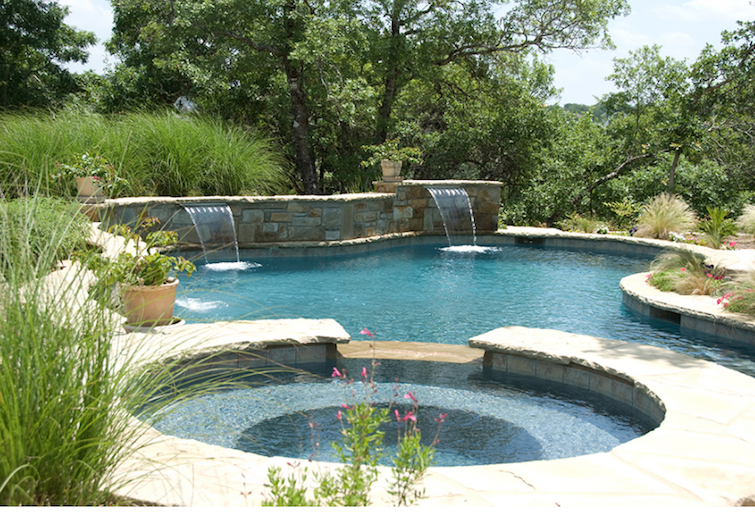How To Clean a Green Pool
October 04, 2016 at 05:54 PM

These days, “green” is usually good, except if that’s the color of your swimming pool’s water. In fact, a green pool usually is a sure sign that your pool chemicals aren’t doing their job.
Pools turn green for a few reasons, but usually it’s because there’s little to no chlorine in the water. Chlorine kills bacteria and algae, which if they’re not eliminated, cause the green hue of your pool.
You might remember that after the Olympic pools in Rio mysteriously turned a brilliant shade of murky emerald despite diligent round-the-clock maintenance, the culprit emerged: a contractor was pouring hydrogen peroxide into the water, which acted as a de-chlorinator and thus rendered the water chlorine-free and vulnerable to environmental effects.
What causes chlorine to deplete? One way is through use – chlorine bonds with organic matter, such as skin and sweat, in order to keep the water clean. Another is through evaporation of pool water into the air, particularly in an outdoor pool. UV rays, from the sun or from a UV filter, will break down chlorine as well.
For these reasons, it’s important to consistently monitor and test your pool’s chlorine and pH levels to ensure there’s enough chemicals present to fight bacteria and algae. pH levels should be between 7.2 to 7.6 for best results.
And if your pool is already green? Follow these steps to take to restore it to its clear, sparkling former self.
- Examine the pool’s murkiness. If it’s green, but still visible about six feet down, then it can be treated with chemicals. A pool that’s been sorely neglected will be cloudy and visibly blacker in color. In that case, your pool pro may suggest that you drain the pool entirely and acid wash to remove the algae stains. However, that’s often a last-resort option, as it can be expensive to drain and refill a pool.
- Skim out leaves and debris, but avoid vacuuming debris until the green has been cleared. Because it is difficult to see the pool bottom, the amount of debris may actually be far more than you can see, and can clog your pipes. Wait until you can see and determine the amount before deciding whether to clean it yourself or call a professional.
- Backwash your filter, if needed. Sand and diatomaceous earth (DE) filters need backwashing, while cartridge filters should be replaced or cleaned. DE filters should be run for at least 24 hours before commencing.
- Shock the pool. If it’s determined that you can treat the existing water, you’ll “shock” the pool with calcium hypochloride. This chemical is added to cover the entire pool while the filter pump is running. After a few hours, you’ll also want to add some algaecide as well. Algaecide is effective in fighting algae, but you always need chlorine alongside it.
- Vacuum the pool if there isn’t a lot of debris. While the pool is being shocked and filtered, you’ll need to clean the green areas as well over the next few days. Your filters will also need a good backwashing after 24 hours of use. After about a day, much of the green color will be gone, though the water may be slightly cloudy. It will take a few days of filtering for the clarity to be fully restored as well.
Once you’ve restored your pool water back to a sparkling clean color, you’ll want to make sure to keep it that way. A few important things to check:
- Chemical levels and pH. Use a test kit to make sure your levels are correct and your pH is within range. Add chemicals accordingly to balance levels if they are incorrect.
- Filters. A poor filter can result in perpetually cloudy water. Make sure your filters are cleaned regularly. DE filters should be backwashed at least once a month, while sand should be done every two weeks. Cartridge filters should be backwashed every 3-4 weeks. Consult a pool technician or your owner’s manual for exact maintenance.
- Chlorinating system. Ensure you have a proper chlorinating system- whether a salt generator or a other system to regularly feed chlorine into the pool. Having chlorine in the pool at all times is crucial to preventing green water and algae from occurring.
- Pool cover. Having a cover on when the pool is not in use can help prevent water evaporation, extra debris in the pool that would react with chlorine, and other environmental exposure.
Keep a calendar for routine maintenance and hire a pool technician to come regularly to vacuum your pool, check your chemical levels, and clean your filters, among other things.
If you discover your pool has turned green, it’s a good idea to talk to an expert to make sure you are using the correct products to treat it. While it’s not difficult to treat the problem, it requires some attention and TLC to ensure that your filters and chemicals are working in sync to bring your pool back to normal.